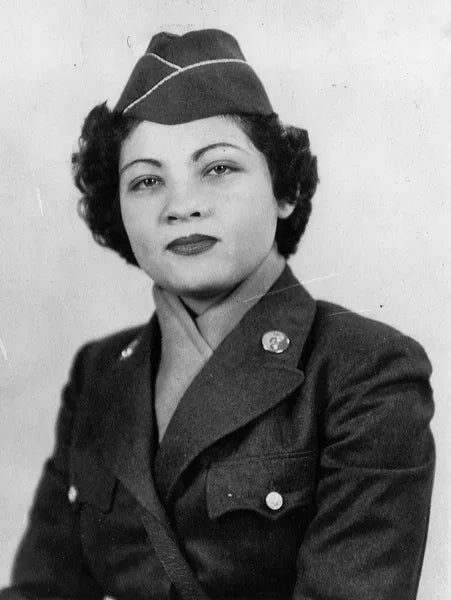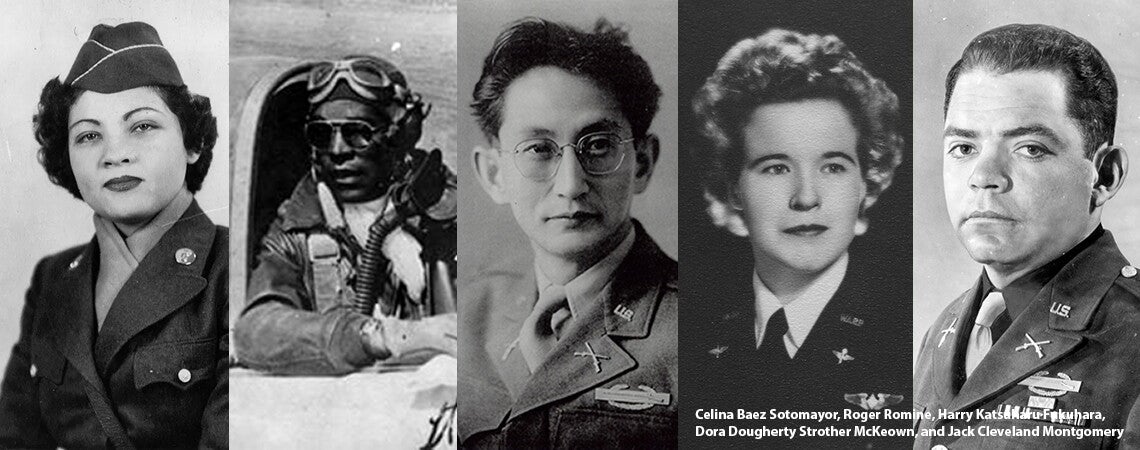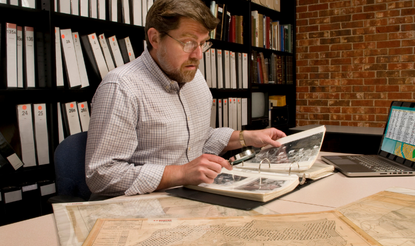"Courage to Face the Unknown": The World War II Service and Legacy of Celina Baez Sotomayor
by Elizabeth R. Escobedo
 During the 1940s hundreds of thousands of American women left their hometowns to serve in the Women’s Army Corps (WAC), a US Army unit created in World War II to enable women to serve in noncombat positions and “free a man to fight.”[1] Lesser known in this history of wartime migration and military service is the role of Puertorriqueñas like Celina Baez, who departed their island home to become the first women (other than nurses) to serve within the ranks of the United States Army, leaving an indelible mark on the US military and metropole.
During the 1940s hundreds of thousands of American women left their hometowns to serve in the Women’s Army Corps (WAC), a US Army unit created in World War II to enable women to serve in noncombat positions and “free a man to fight.”[1] Lesser known in this history of wartime migration and military service is the role of Puertorriqueñas like Celina Baez, who departed their island home to become the first women (other than nurses) to serve within the ranks of the United States Army, leaving an indelible mark on the US military and metropole.
Born in 1927 near the town of Lajas in Puerto Rico—a colonial island territory of the United States—Celina Baez had an early life defined by devastating poverty and loss. Celina’s father abandoned the family when she was an infant, and her mother was an invalid who died when Celina was just nine years of age. Thereafter an orphaned Celina lived in San Germán in the home of her older sister Aurora, where she contributed to the household by sewing handkerchiefs to help make ends meet. Though Celina struggled to make friends and found school a lonely experience, she enjoyed passing the hours in the library, happily burying her nose in any book she could get her hands on.[2]
As Celina grew older, she dreamed of escaping her strict upbringing and precarious economic situation, and World War II represented a window of opportunity. In 1944, a seventeen-year-old Celina saw an ad in a local Puerto Rican newspaper that the WAC planned an upcoming island recruitment campaign. Although technically too young to join, she was determined to pave a new life for herself. She submitted her name for consideration, lying about her age. When WAC recruiters invited her to San Juan for further consideration, Celina told her sister that she had received an official order from the US Army and had no choice but to follow it. Shortly thereafter she embarked on an hours-long train ride to the city, later recalling the trip as a grand adventure.[3]
In San Juan, Celina competed with over 1,500 women from across the island to secure a coveted spot in the WAC.[4] Initially the US Army balked at recruiting Puertorriqueñas outside of the continental United States, citing a lack of available facilities and personnel in Puerto Rico.[5] Yet by 1943 the Women’s Army Corps faced a significant shortage of recruits, largely due to societal fears of women taking on “masculine” duties of soldiering and rumors from within the military that servicewomen were sexually promiscuous and immoral.[6] Despite the negative characterizations, Puerto Rican women across the island sent scores of letters to US officials expressing their desire to serve in the global war for peace and democracy, and by 1944 the US Army allowed for a modest quota of 200 women from the island to enlist.[7] During the recruitment process, interested Puertorriqueñas like Celina Baez were asked to complete a battery of tests and interviews—all in English and more rigorous than those administered to their metropole counterparts, a decision largely informed by WAC officials’ colonial assumptions that mixed-race, Spanish-speaking islander women were less reputable and capable than recruits living in the US metropole.[8]
Celina’s strong performance during the recruitment process earned her a place in the Women’s Army Corps. When WAC recruiters asked for her birth certificate, an enterprising Celina convinced her older brother to have the document forged. With paperwork in hand, Celina embarked on a military flight to the US metropole with fellow Puerto Rican WAC recruits—many of whom had never before left their island home—and landed in Miami in December 1944 without proper clothing to keep them warm. Celina fondly remembered the kindness of a Black conductor who provided blankets to the women as they journeyed by train to Georgia for basic training. At the Fort Oglethorpe WAC Training Center the chilly weather continued, and the winter wool skirts, stockings, and coats provided by the WAC were quite a novelty to young women accustomed to a tropical climate. During basic training, Celina and her fellow Wacs rose early and kept a rigorous schedule of classes on Army protocols in addition to extensive drill and physical training. Recruits also engaged in kitchen duty and learned clerical and communication skills. Many of the daily tasks were decidedly unfamiliar to Celina, who prior to her military service had never lit a chimney stove let alone operated a telephone.[9]
Celina and a majority of her fellow Wacs from the island served in segregated Puerto Rican units, both during basic training and in their later military placement in the Post Office of the Port of Embarkation of the Army Transportation Corps in New York. US troops were segregated by race in World War II, and when Puertorriqueñas from the island entered the metropole, US Army officials determined that the racial ambiguity of the mixed-race Puerto Rican population, in addition to colonial-based assumptions about their limited English language skills and respectability, warranted separation from other Wacs.[10] Stationed in New York in early 1945, Celina and her fellow Puertorriqueñas lived in the Broadway Central Hotel and worked at the post office on 42nd Street, sorting and processing letters and packages for the troops in Europe.[11] Though the hours were long and the work monotonous, their efforts were indispensable for troop morale, keeping soldiers in contact with loved ones while overseas. WAC officers who worked closely with Celina’s unit praised the strength and commendable conduct of the servicewomen, their efficient work a reflection of Puerto Rico’s invaluable contributions to the war.[12]
On a personal level, Celina’s service in New York allowed her to broaden her horizons and experience for the first time an “unthinkable, giddy new freedom.” During her off-duty hours she traversed the city with fellow Wac and friend Carmin, feeling a sense of liberation as she frequented shows of popular entertainers like Frank Sinatra and Tommy Dorsey, often free of charge for men and women in uniform. Her wartime experiences practicing English and participating in military life in the US metropole made her feel more “rightfully American” than she ever had before. [13]
It was in New York that Celina also met her future husband, a turn of events that informed her decision to stay in the metropole once her military service ended. Celina first encountered Juan Luis Sotomayor, fondly known as Juli, when she accompanied Carmin to a party in the Bronx. A native of Puerto Rico, Juli attended school on the island through the sixth grade when he joined the factory workforce to help support his family. In December 1944, around the very same time that Celina arrived in the metropole, the twenty-two-year-old Sotomayor and his family moved to New York in search of work and economic opportunity. Upon their meeting, Juli and Celina felt a great affinity for one another, sharing a mutual love of poetry and discussing the current events highlighted in New York’s El Diario newspaper. He wrote her letters during their courtship, and Celina and Carmin regularly found their way back to the Bronx on their off-duty hours. With her discharge from the military on the horizon, Celina made the decision to stay in the metropole and to build a life with Juli in New York.[14]
The Sotomayors had two children—Sonia in 1954 and Juan in 1957—and lived in housing projects in the Bronx. In the first years of their marriage Celina completed high school and became a practical nurse at Prospect Hospital. When Juli passed away in 1964, Celina raised Sonia and Juan as a single mother, working long hours to make ends meet, and still finding time to serve as an unofficial caregiver for friends and neighbors. As the family struggled financially, she entered a bilingual community college program to receive her nursing degree, with hopes of earning more pay as a registered nurse. She studied all hours of the day and night, struggling mightily with feelings of insecurity and worries that her English skills were too poor to pass the nursing examinations. In the end, Celina’s fears were for naught—she passed every one of her qualifying exams on the first try. She became the emergency room supervisor at Prospect Hospital until it closed in the mid-1980s. Thereafter she worked in a methadone clinic in the South Bronx until she retired. Celina’s efforts taught her children the importance of an education and a strong work ethic in pursuing one’s dreams, lessons that Juan and Sonia took to heart in their respective professional pursuits in medical and law school. Celina never lost the adventurous spirit of her Army days, however. In later years, after almost fifty years of living in New York, she made the decision to pick up and move to Florida on a whim after vacationing there with her partner, Omar Lopez. The two married in 1998 and settled in a retirement community in South Florida.[15] Lopez passed away in 2015, and Celina in 2021, at the age of 94.[16] Celina is buried in South Florida National Cemetery in Lake Worth, Florida.
Ours would be a different country had Puerto Rican women like Celina Baez Sotomayor not met with bravery and determination the call to join and support the Allied cause. As evidence, one need look no further than the day in 2009 when Celina, tears of pride streaming down her face, stood beside her daughter, Sonia Sotomayor, as she was sworn in to become the first Latina Supreme Court Justice in the United States. As Justice Sotomayor recounts in her memoir, much of her path to this high honor was paved by her mother who instilled in her “the values that came naturally to her—compassion, hard work, and courage to face the unknown.”[17] Theirs is a uniquely American story, and the contributions of Celina Baez Sotomayor and other Puerto Rican Wacs is deserving of recognition and a prominent place in the history books.
Elizabeth R. Escobedo is an associate professor of history at the University of Denver. She is the author of From Coveralls to Zoot Suits: The Lives of Mexican American Women on the World War II Home Front (Chapel Hill: University of North Carolina Press, 2015) and an upcoming book on Mexican American and Puerto Rican women in the World War II US Armed Forces.
[1] For an in-depth study of the Women’s Army Corps, see Leisa Meyer, Creating GI Jane: Sexuality and Power in the Women’s Army Corps during World War II (New York: Columbia University Press, 1996).
[2] Sonia Sotomayor, My Beloved World (New York: Vintage, 2013), 65–70.
[3] Sonia Sotomayor, My Beloved World, 71.
[4] “Memorandum for Chief, Appointment and Induction Branch, AGO, Subject: Report of WAC Recruiting Activities in Puerto Rico,” December 11, 1944, Army-AG, Project Decimal File 1940–45 “Special Projects,” RG 407, Box 4292, National Archives and Records Administration (hereafter NARA).
[5] “No podrian alistarse en la Isla cuerpos auxiliaries,” El Mundo, 17 de Julio de 1942.
[6] Meyer, Creating GI Jane, 33–50.
[7] Letters from Puerto Rican women interested in joining the Women’s Army Corps can be found in RG 548, Records of US Army Forces in the Caribbean, Antilles Dept. 1939–1947, Box 106, Folders “320.2—WAACs & WACs 2/43 3/44” and “AG—320.2 WAAC 7/42 11/42 Binder #1,” NARA; Office of the Chief of Military History, “The Puerto Rican Induction Program and the Use of Puerto Rican Troops” (Washington, DC: Department of the Army, 1948), 172.
[8] “Report of WAC Recruiting Activities in Puerto Rico.”
[9] Sonia Sotomayor, My Beloved World, 71–74; “WACS de Pto. Rico empezaron clases,” El Mundo, 27 de Octubre de 1944.
[10] “The Puerto Rican Induction Program,” 175; “Report of WAC Recruiting Activities in Puerto Rico.”
[11] Sonia Sotomayor, My Beloved World, 74.
[12] “171 boricuas en espera de licenciamiento,” El Mundo, 14 de Octubre de 1945.
[13] Sonia Sotomayor, My Beloved World, 73.
[14] Sonia Sotomayor, My Beloved World, 75–78.
[15] Sonia Sotomayor, My Beloved World, 78, 83–84, 144–45, 176, 376; “A Judge’s Own Story Highlights Her Mother’s,” New York Times, May 27, 2009.
[16] Ariana de Vogue, “Celina Sotomayor, mother of Supreme Court justice dies at 94,” CNN, July 26, 2021.
[17] Sonia Sotomayor, My Beloved World, 384.



